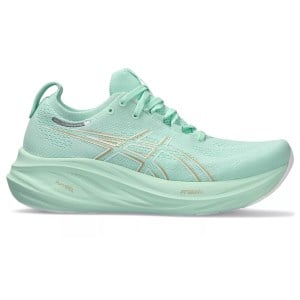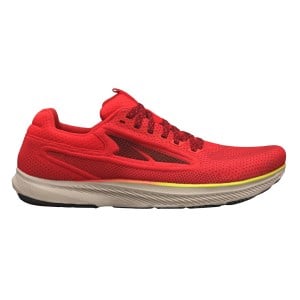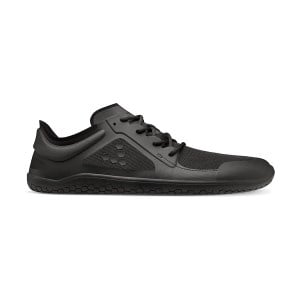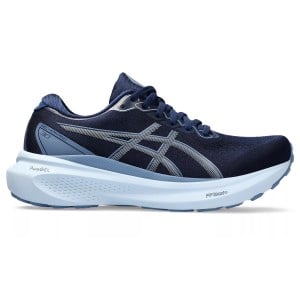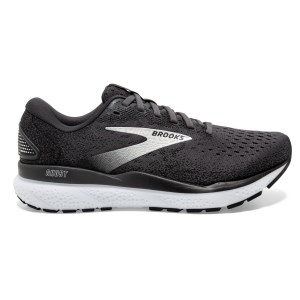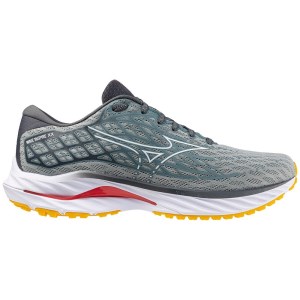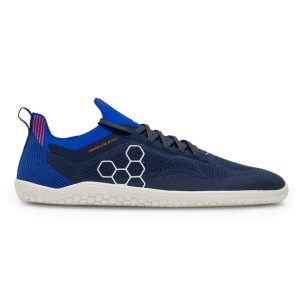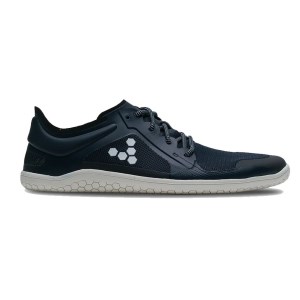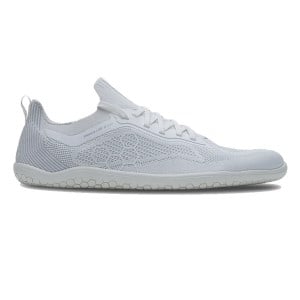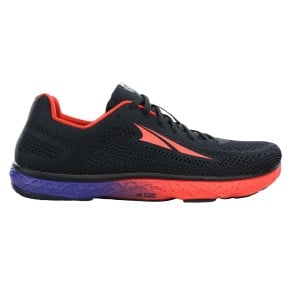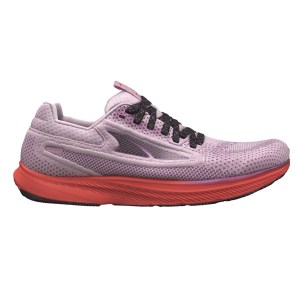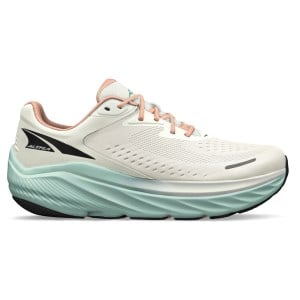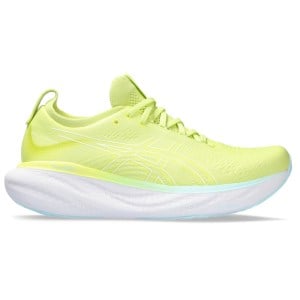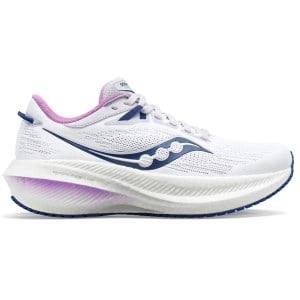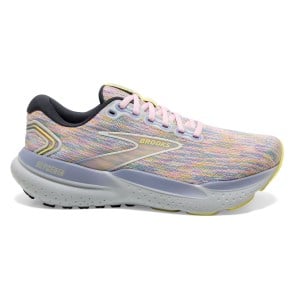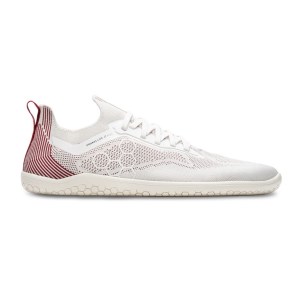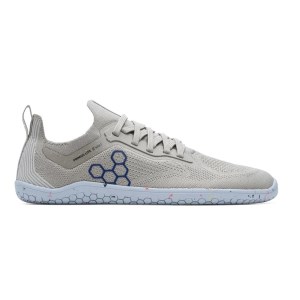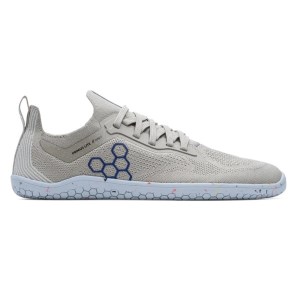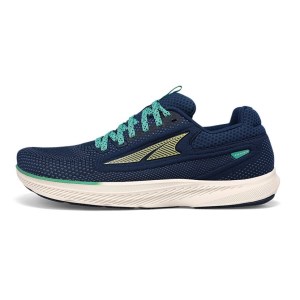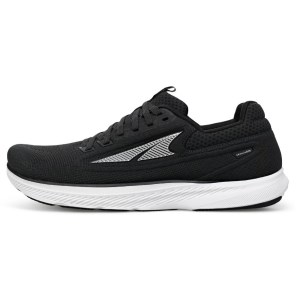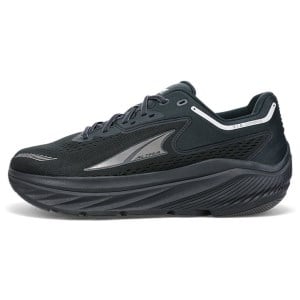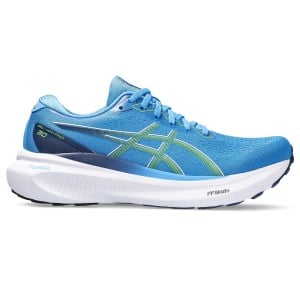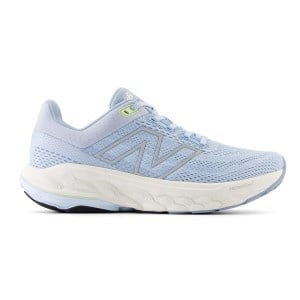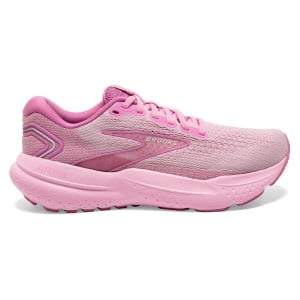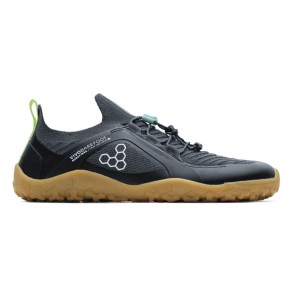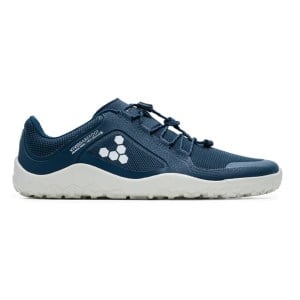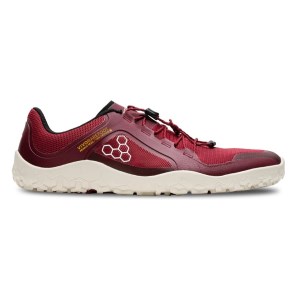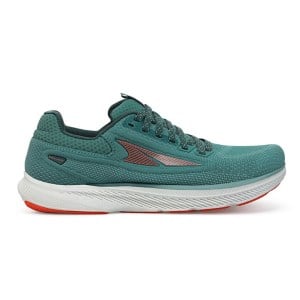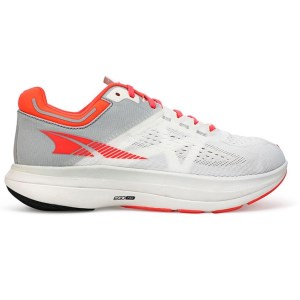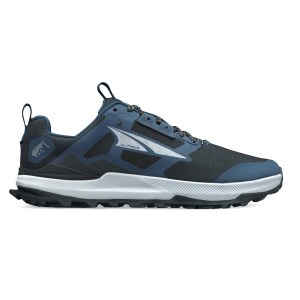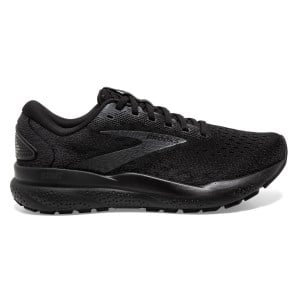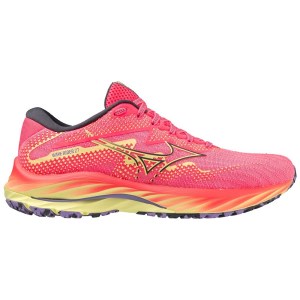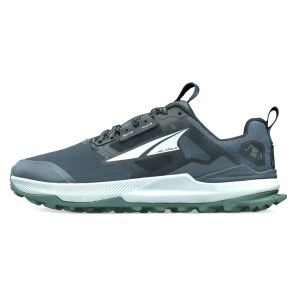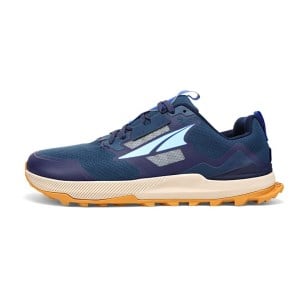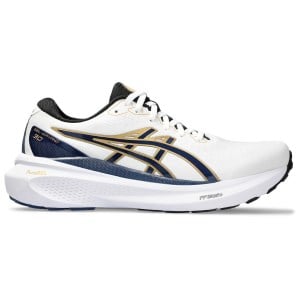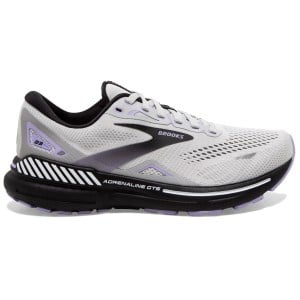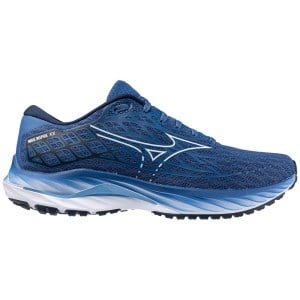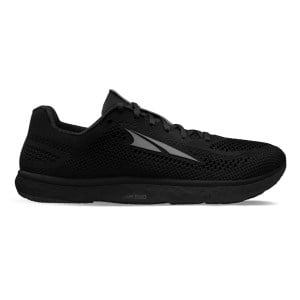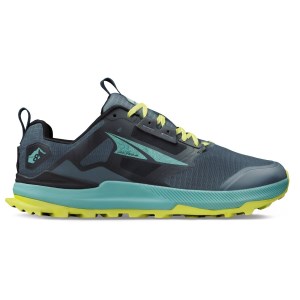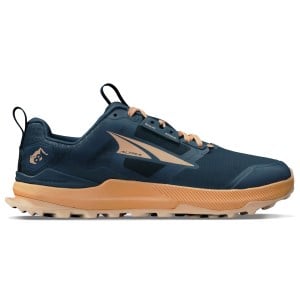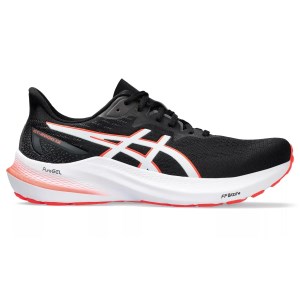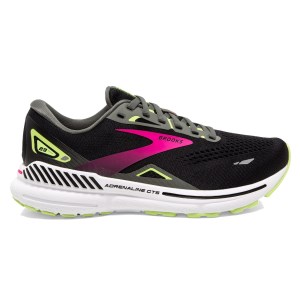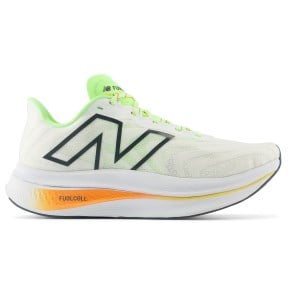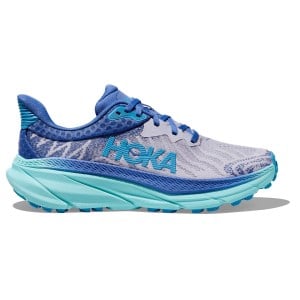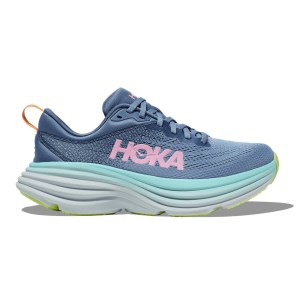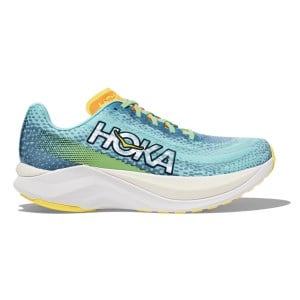Barefoot vs Minimalist vs Traditional Running Shoes - Which Is Better For Your Feet?

The barefoot movement expresses that your feet didn’t evolve to wear shoes. Conventional theory argues, you didn’t evolve to run on hard road surfaces either and traditional running shoes compensate for that.
With all honesty, you could spend hours untangling the contradicting studies on the matter – with scientists, podiatrists and athletes all weighing in with clashing opinions.
Instead, we’re going to break down the basic features of barefoot, traditional and minimalist running shoes and put them side by side to help you decide which should be the next addition to your shoe rotation.
We'll talk about and visually compare conventional running shoes from brands like Asics and Brooks with Vivobarefoot barefoot running shoes to highlight how the engineering and benefits vary between these categories.
Alongside minimalist running shoes, we'll discuss a unique category we refer to as 'natural fit, cushioned' running shoes. We'll put the spotlight on the brand Altra that's both protective and barefoot-inspired, blurring the lines across the different running shoe types.
Lastly, we'll take a closer look at max cushioned shoes like Hoka which have gained momentum in recent years and evolved virtually as a category of their own. With this insight, you can discover the shoe category that best matches the running experience and feel you’re hoping to achieve to support your performance and the health of your feet.
-
Asics Gel Nimbus 26 - Womens Running Shoes
-
Altra Escalante 3 - Mens Running Shoes
-
Vivobarefoot Primus Lite 3.0 - Mens Running Shoes
Weight
Traditional / conventional running shoes:
Top traditional running shoe brands continue to engineer or evolve new tech to create a lighter ride through lightweight cushioning foams. This includes Asics FlyteFoam, Brooks DNA Loft, New Balance Fresh Foam and Adidas Lightstrike Pro which provide varying blends of shock absorption and responsiveness.
Weights also vary significantly based on the purpose of the shoe. Interval running shoes or traditional racing shoes potentially strip back on weight and structure for a focus on speed. High mileage running shoes offer more cushioning and durability, with the trade-off being more weight.
Super trainers are a hybrid between the two. They have evolved to fulfil a need in the running world as trends change and technologies advance, combining large performance-based midsoles with lightweight support.
Stability running shoes like the Asics Gel Kayano that feature additional arch support for overpronation control tend to weigh more than neutral running shoes, with specialised technologies to guide the foot into a more neutral and efficient motion path.
-
Asics Gel Kayano 30 - Womens Running Shoes
-
newBrooks Ghost 16 - Mens Running Shoes
-
Mizuno Wave Inspire 20 - Mens Running Shoes
Barefoot running shoes:
No surprises here – true barefoot running shoes like Vivobarefoot are by far the lightest, usually weighing less than 200 grams. In their nature, barefoot running shoes have zero cushioning and stability characteristics, allowing you to rely solely on your body’s natural shock absorbing mechanisms.
They’re designed to conform more naturally to the shape and structure of the foot, and only provide ultra-thin protection of the outsole for increased sensory feedback and reduced bulk.
Overall, these running shoes create an ultra-lightweight, barely-there barefoot experience and reduce energy wastage as there’s less weight to carry. This isn't to say that newly developed conventional running shoes don't have their own unique engineering to save energy - with rocker geometries designed with this goal in mind.
-
Vivobarefoot Primus Lite Knit - Mens Running Shoes
-
Vivobarefoot Primus Lite 3.0 - Mens Running Shoes
-
Vivobarefoot Primus Lite Knit - Womens Running Shoes
Minimalist running shoes:
In terms of weight, minimalist running shoes generally fall somewhere in the middle. They still offer a degree of cushioning, but not in excess. Their goal is to maintain a more natural running gait with less reliance on cushioning than a traditional running shoe, while offering more impact protection than a barefoot running shoe – and their weight is a reflection of that.
Natural fit, cushioned running shoes:
In terms of barefoot-inspired (not 'true' barefoot or minimalist) running shoes, the focus may be more on achieving a natural fit on a cushioned platform, rather than a natural fit with zero cushioning.
Altra is spearheading this 'natural fit, cushioned' category that has emerged out of a need to provide a fit that's honest to your anatomy, while offering protection for runners that prefer or need it, such as for injury prevention or running longer distances.
Alike with conventional running shoes the weight is very dependent on the specific model and its purpose - with the highly cushioned Altra Olympus trail running shoes potentially weighing over 300 grams, whereas the Altra Escalante Racer weighs closer to the 200 grams mark. The Altra Escalante Racer and Altra Escalante 3 align more closely to the minimalist shoe category compared to Altra's heavier, higher stacked running shoe models.
-
Altra Escalante Racer - Mens Running Shoes
-
Altra Escalante 3 - Womens Running Shoes
-
Altra Via Olympus 2 - Womens Running Shoes
Heel-to-toe Drop

Traditional / conventional running shoes: 8-12mm drop
Also called shoe drop, shoe offset, gradient or pitch, the heel-to-toe drop is a measurement of the difference between the heel height and the forefoot height of the running shoe. Higher heel-to-toe drops correspond with elevated heels.
Heel drops can vary among models and brands, with Asics running shoes, Brooks running shoes and Mizuno running shoes generally sticking with the trusted 10-12mm heel drop.
However, running shoe brands may break boundaries or convention. The Asics Gel Nimbus 25 provides a slightly more balanced feel with an 8mm heel-to-toe drop, whereas the Saucony Triumph 21 steers away from the more minimalist designs that once defined the brand for a 10mm heel-to-toe drop.
A shoe drop of 8 - 12mm paired with a moderate to high stack height (the measurement of how thick the shoe is beneath your foot at its maximum point) accommodates cushioned midsole technologies. This allows running shoe brands to create a plush, dampened feel for tackling repetitive impacts during high mileage running up to marathon distances, daily training or easy-going recovery runs.
With more substance in the heel, these running shoes often cater to and help disperse forces involved in high-impact heel strikes. Also, they're a more suitable option for runners susceptible to Achilles tendonitis, as they target impact stress away from the lower leg, to the upper knees and hips.
Check out Everything You Need To Know About 10mm+ Drop Running Shoes for more information.
-
Asics Gel Nimbus 25 - Mens Running Shoes
-
Saucony Triumph 21 - Womens Running Shoes
-
Brooks Glycerin 21 - Womens Running Shoes
Barefoot running shoes: 0mm
Barefoot shoes like Vivobarefoot running shoes have a heel-to-toe drop of 0mm, translating to an entirely level platform between forefoot and heel, and coupled with an extremely thin stack height for a low-to-ground feel.
As there is no elevated heel, the philosophy behind barefoot shoes is that they improve posture and balance to run more naturally. Having a zero drop emphasises or encourages the forefoot and potentially midfoot strike. In fact, heel striking in barefoot shoes puts you at high risk of injury.
With a 0mm heel drop and zero cushioning, heel protection simply isn’t there. Heel striking in barefoot shoes hurts - encouraging you to adapt to running with a more prominent forefoot or midfoot strike. These are generally considered as the more natural running strides, even though heel strikers make up the majority of runners.
It's worth noting that when you are fatigued on a long run, your proper running form may suffer and tend towards a heel strike - which for safety's sake, isn't compatible with barefoot shoes. Although they may be more biomechanically efficient, and this is up for debate, the fact that barefoot shoes are free of cushioning technologies may cause your feet to fatigue faster – so it’s a game of weighing up the pros and cons.
-
Vivobarefoot Primus Lite Knit - Mens Running Shoes
-
Vivobarefoot Primus Lite Knit - Mens Running Shoes
-
Vivobarefoot Primus Lite Knit - Womens Running Shoes
Minimalist running shoes: Less than 8mm drop
Traditionally, most Saucony running shoes offered a minimalist, low profile feel with 4-8mm heel drops. 4mm drops and lower allow runners to break free from the dependence on the stability and cushioning characteristics of the running shoes, putting more focus on the tools you were born with for natural motion.
With less physical heel getting in the way, heel strikers transitioning to minimalist running shoes may find they have a less pronounced heel strike, which may translate to improved running efficiency as striking the ground heel-first tends to act as a brake.
In recent years, the heel drops and stack heights of Saucony shoe models that were once considered minimalist like the Saucony Kinvara have been on the rise, perhaps chasing the trend of max cushioned running shoes which have increased in popularity in recent years.
Natural fit, cushioned running shoes:
If we take a look at the brand Altra, the heel drop of their running shoes is consistent across virtually all models - being 0mm (the Altra FWD Experience is the exception with a 4mm drop).
They refer to this as their 'Zero Drop' design or 'Balanced Cushioning' platform - with the height of Altra running shoes the same from heel to forefoot, without any elevated heel to create a gradient or slope. According to Altra, "This natural foundation aids in optimal alignment, cultivates better form, and encourages a low impact landing" - translating to less over-striding or heel striking.
However, this doesn't mean Altra fit in the barefoot or even the minimalist category of running shoes. In fact, according to Altra, "we created the world's first cushioned, Zero Drop shoes. We built them to be optimal for long distances and to avoid the foot problems that are now common with minimalist shoes."
Altra don't steer away from providing cushioning underfoot - which can be very generous in some of their models like the Altra Via Olympus compared to others like the Altra Escalante, which offers a more close-to-ground feel. The formula behind Altra running shoes is a more natural fit and balanced posture, combined with an element of shock absorption - essentially, a barefoot-inspired running shoe that doesn't skimp on protection.
Check out Everything You Need To Know About 0 - 4mm Drop Running Shoes for more information.
-
Altra Escalante 3 - Mens Running Shoes
-
Altra Escalante 3 - Womens Running Shoes
-
Altra Via Olympus - Mens Running Shoes
Outsole: Durability and protection vs flexibility and sensory feedback

Traditional / conventional running shoes:
The purpose of the outsole is to provide durability, traction and a protective barrier between your feet and hard or hazardous surfaces.
Traditional running shoe outsoles contain grooves or channels to provide grip for forward-motion. The forefoot area tends to be particularly flexible to allow for snappy toe-off and a responsive feel, while the heel tends to be thicker and more durable to withstand repetitive impacts.
Conventional outsoles are often made with airy and flexible blown rubber for a cushioned feel and/or heavier carbon rubber for increased durability. In the case of the Asics Gel Kayano 30, AHARPLUS carbon rubber reinforces the high-wear zone of the heel - catering to heel strikers and increasing the lifespan of the running shoe.
If you hold a traditional shoe with forefoot in one hand and heel in the other, and twist in opposite directions, you’ll find there is considerable resistance from the outsole, with their underfoot rigidity helping maintain structure.
-
Asics Gel Kayano 30 - Mens Running Shoes
-
New Balance Fresh Foam X 860v14 - Womens Running Shoes
-
Brooks Glycerin 21 - Womens Running Shoes
Barefoot running shoes:
The outsole of barefoot running shoes is ultra-flexible from heel-to-toe. Vivobarefoot running shoes can be scrunched into a ball and quickly spring back into shape. Your feet can run and flex naturally and every muscle can be put to work without restrictions.
They’re also incredibly thin to literally allow you to feel more of the world beneath your feet. Like your hands, your feet have sensitive nerve endings and barefoot shoes allow you to use your body’s natural tools to improve sensory feedback and proprioception - that is your awareness of your body in space.
-
Vivobarefoot Primus Trail Knit FG - Mens Trail Running Shoes
-
Vivobarefoot Primus Trail 2.0 FG - Mens Trail Running Shoes
-
Vivobarefoot Primus Trail 2.0 FG - Mens Trail Running Shoes
Minimalist running shoes:
The outsole of minimalist running shoes are generally thinner than a traditional outsole, but with more sturdy protection than an ultra-thin barefoot outsole. Typically, they aim to be structurally light and feel fast without overly compromising on durability.
When running shoe brands get it right it can offer an ideal balance for road warriors seeking a hybrid between a traditional and barefoot shoe, but it can be a hit and miss depending on the model and manufacturer. Stripping back the outsole too much, particularly in high-wear areas, runs the risk of the shoe wearing out prematurely and may neglect to provide enough protection of the midsole.
Natural fit, cushioned running shoes:
If you turn the Altra running shoes upside-down you'll find that the flex grooves are strategically placed to follow the anatomy of your feet. Altra called this signature design their FootPod outsole, taking inspiration from the structure of bones and tendons in human feet. This supports increased flexibility, responsiveness, traction and movement that aligns more naturally with your biomechanics.
Without the restrictions of barefoot or minimalist shoe brands, Altra are able to provide this foot-inspired outsole on durable, cushioned platforms.
-
Altra Escalante 3 - Womens Running Shoes
-
Altra Vanish Tempo - Womens Running Shoes
-
Altra Lone Peak 8 - Mens Trail Running Shoes
Midsole: Cushioning

Traditional / conventional running shoes:
Traditional road running shoe manufacturers engineer solutions to the problem of repetitive impacts on hard surfaces, being tarmac, concrete and pavement. They design cushioning midsole technologies to protect and reduce fatigue for runners to conquer more kilometres in comfort.
As we move forward, these midsole technologies are progressively becoming lighter to fit the needs of everyone from the weekend jogger to the elite marathon runner. Different brands and models of running shoes will deliver a different feel based on their specific cushioning engineering, density and formula.
First and foremost, the goal is comfort to support wellbeing and performance, and protection for reduced risk of overuse injuries. From here, a specific model may gear towards more plush and pillow-soft cushioning, more firm and responsive cushioning, or a balance between the two. Not only do these technologies compress on impact to absorb shock, but the more innovative foams will bounce back into shape quickly to help you spring into your next stride like Asics FlyteFoam.
Brooks DNA Loft cushioning - with a formula of air, nitrogen, foam and rubber - provides lightweight softness and responsiveness. The Brooks Ghost 16 provides buttery-soft DNA Loft v3 in a lightweight, more balanced package, whereas the Brooks Glycerin 21 offers an even softer experience with its specific geometry and higher stack height.
Although all road runners can enjoy protective cushioning, under pronators / supinators with high arched feet that roll outwards in particular, may benefit from cushioned shoes. This foot type is unable to provide adequate natural shock absorption with the arch’s inability to ‘collapse’ and cushion on impact.
-
newBrooks Ghost 16 - Mens Running Shoes
-
Mizuno Wave Inspire 20 - Womens Running Shoes
-
Mizuno Wave Rider 27 - Womens Running Shoes
Barefoot running shoes:
Barefoot running shoes like the Vivobarefoot Primus family focus on bare minimum when it comes to the midsole. Arch support and cushioning technologies don't fit into the barefoot principle of allowing your feet to move and engage 100% naturally.
A highly cushioned running shoe can feel like you’re wearing tiny pillows on your feet, or 'clouds' in the case of On Running and their innovative CloudTec. Although this is exactly the experience many runners are hoping for, being free of the dampening effects of cushioning in barefoot shoes allows for improved sensory connection with the road or trail and heightened proprioception.
Barefoot shoes aim to make you literally feel more by putting less interference between you and your running surface.
Feeling every pebble beneath your feet provides an additional level of stimulation for your brain. It will react to changed conditions and relay messages to your feet to instinctively stabilise when the ground underfoot becomes rocky or hazardous – in a similar way you’d flinch unconsciously if you step on something sharp.
Wearing barefoot shoes allows your body’s natural defences to be put into play – but does run the risk of pain or injury especially over long distances, hard surfaces and if you haven’t gradually transitioned to the barefoot lifestyle. As we touched on earlier, this can be more of a challenge for severely supinated (high arched) foot types – with inadequate cushioning causing higher risk of stress fractures.
-
Vivobarefoot Primus Lite Knit - Mens Running Shoes
-
Vivobarefoot Primus Lite 3.0 - Mens Running Shoes
-
Vivobarefoot Primus Lite Knit - Womens Running Shoes
Minimalist running shoes:
Many minimalist running shoes often provide a degree of cushioning - combining a close-to-ground feel with an element of protection.
Natural fit, cushioned running shoes:
Although Altra running shoes aren't technically minimalist, their more close-to-ground models do provide a middle ground between traditional and barefoot running shoes. They combine a 0mm drop for a balanced, natural posture with shock-absorbing cushioning.
A minimalist shoe will offer greater sensory feedback than Altra. Keep in mind that many models in the Altra range provide soft, thick midsoles underfoot, like the Altra Via Olympus 2 - even potentially providing more cushioning than a traditional running shoe. This model features Altra EGO MAX foam that creates a protective barrier between your feet and the ground.
Perhaps a better word to describe Altra running shoes would be transitional. Their models that feature more minimal cushioning like the Altra Lone Peak trail running shoes and Altra Escalante are ideal options for runners to potentially trial before transitioning to barefoot running shoes.
If you are hoping for a truly barefoot experience, choose Vivobarefoot, but if you're seeking a shoe that provides protection to beaten up feet while offering a natural-feeling fit, Altra should be on your radar. Both may have a place in your shoe rotation for specific running workouts.
-
Altra Escalante 3 - Mens Running Shoes
-
Altra Lone Peak 8 - Womens Trail Running Shoes
-
Altra Lone Peak 7 - Mens Trail Running Shoes
Midsole: Stability And Support
Traditional / conventional running shoes:
Overpronation – that is, the excessive inward rolling or rotation of the foot due to low or flat arches – is common among many runners. It may cause muscle stress to the inner edge of the foot and prevent a neutral distribution of load through the sole. Pain, if evident, may not only be isolated to the arches, but can affect your Achilles tendons, ankles, heel, shins, knees and hips.
Top running shoe brands provide a solution in their stability running shoe categories with more structured cushioning and firmer midsoles to support the arches and better align your gait. The 4D Guidance System in the high-performance Asics Gel Kayano 30 - Asics' flagship stability running shoe - smoothly reduces the rate of overpronation.
Running brands like Brooks focus on how running affects your body from foot, to knee, to hip. They specialise in guiding rather than correcting the movement of your feet as you transition through the gait cycle. Overpronation-friendly tech like the GuideRails in the Brooks Adrenaline GTS 22 only kick into action to stabilise your motion when you need that touch of extra support, to prevent overly interfering with your natural stride.
-
Asics Gel Kayano 30 Anniversary - Mens Running Shoes
-
Brooks Adrenaline GTS 23 - Womens Running Shoes
-
Mizuno Wave Inspire 20 - Mens Running Shoes
Barefoot running shoes:
According to the barefoot movement, it’s less about the structural issues of whether you have collapsed arches and flat feet that lack support, or high arches that offer minimal natural cushioning, and more about how strong your arches actually are.
Weaker arches, whether low, neutral or high, are potential causes for pain and discomfort – as the tiny bones, ligaments and tendons in your foot can not as readily provide support. Being free of arch support and orthotics, barefoot running shoes force the muscles in your feet to do the work – and like any muscle, they become stronger as a consequence of being activated.
With your muscles doing the heavy lifting, your body learns to adapt, and your feet will strengthen - which may mean less injury risk in the long run, but again, this is debatable and every foot is different.
-
Vivobarefoot Primus Lite Knit - Mens Running Shoes
-
Vivobarefoot Primus Lite Knit - Mens Running Shoes
-
Vivobarefoot Primus Lite Knit - Womens Running Shoes
Minimalist running shoes:
True minimalist shoes cut back on arch support and stability characteristics, prioritising a natural ride with minimal interference to your unique stride.
Natural fit, cushioned running shoes:
Specific Altra running shoes combine barefoot-inspired features like Altra's FootShape Fit and Zero Drop design with stability characteristics. The Altra Paradigm and Altra Provision cater to overpronated foot types with Altra's GuideRail technology that provides smooth, unobtrusive guidance.
True to the philosophy of Altra, these models provide the stability that minimalist or barefoot running shoes lack, while supporting a natural-feeling stride.
-
Altra Escalante 3 - Mens Running Shoes
-
Altra Escalante 3 - Womens Running Shoes
-
Altra Via Olympus - Mens Running Shoes
Upper: Toe Box

Traditional / conventional running shoes:
Conventional running shoe toe boxes vary significantly across brands and models – from shallower to more wider widths, and generally don’t conform as naturally to the foot shape as barefoot shoes.
With a more structured, stiffer feel than barefoot styles, the deeper toe boxes in some traditional running shoes can run the risk of feeling a touch boxy. Potentially seek a running shoe with narrower width offerings if this is more fitting with your foot type.
However, many models from high-end running brands factor in the necessity for toe boxes to be flexible and spacious enough to accommodate the natural swelling and lengthening of the forefoot – particularly in the case of high mileage running. Traditional racing shoes intended for shorter distances tend to offer a snugger fit, keeping the running shoe light and secure during high-speed competition.
-
Asics Gel Kayano 30 - Womens Running Shoes
-
newBrooks Ghost 16 - Mens Running Shoes
-
Mizuno Wave Inspire 20 - Mens Running Shoes
Barefoot running shoes:
Barefoot toe boxes are wide to accommodate the natural splaying of the toes on impact for a more even distribution of stress and dispersal of shock.
Look at your feet. The widest part of your foot is anywhere from where your toes meet the rest of your foot, to the end of your toes. Shoes that taper aggressively inwards at the forefoot simply aren’t designed for natural movement as they squash or constrict the toes. That’s exactly what barefoot shoes combat – providing plenty of toe wiggle room with broad, foot-shaped toe boxes to support natural function to benefit the entire foot.
Some barefoot shoes go the next level to achieve a glove-like, anatomic fit to better resemble a truly barefoot experience. They feature individual compartments for each toe to allow the smallest muscles in your feet to activate, adapt and grip onto changing terrain and move more independently of your other toes – acting like a second-skin.
-
Vivobarefoot Primus Lite Knit - Mens Running Shoes
-
Vivobarefoot Primus Lite 3.0 - Mens Running Shoes
-
Vivobarefoot Primus Lite Knit - Womens Running Shoes
Minimalist running shoes:
Minimalist running shoes tend to fit in the middle – not quite as prominently foot-shaped as barefoot shoes as they widen out in the forefoot, but with a touch more wiggle room than many traditional styles.
Natural fit, cushioned running shoes:
The toe box is one of the areas where the similarities over the differences between Altra running shoes and barefoot running shoes shine. Altra's signature FootShape fit is wider and more generous at the forefoot than a typical traditional running shoe. Like a barefoot running shoe, Altra allows you to splay and engage your toes - providing stability while also promoting the natural strengthening of your feet.
To refine the fit, Altra's signature FootShape is available in different styles based on the specific model - the Original FootShape Fit (the roomiest), Standard FootShape Fit (the most common) and Slim FootShape Fit (for a snugger feel without compromise to movement).
In designing their running shoes, Altra also keeps the biological differences between women and men in mind for a fit that feels personalised to you.
-
Altra Escalante Racer - Mens Running Shoes
-
Altra Lone Peak 8 - Mens Trail Running Shoes
-
Altra Lone Peak 8 - Womens Trail Running Shoes
Toe Spring

Traditional / conventional running shoes:
Place your conventional running shoes on a flat surface and you’ll notice the toe box is slightly raised above the ground in an upward curve.
This feature, called a ‘toe spring’ or forefoot rocker, is common to traditional running shoes. It helps to support the forward rolling motion of the foot as you transition through your gait cycle.
Coupled with the forefoot flexibility of the outsole, this allows the shoe to compress at the toe during your runs for smooth propulsion at toe-off. This also helps prevent your running shoes from feeling overly rigid or restrictive to compensate for a stiffer construction.
There has been a trend recently for some running shoes like super trainers to have a more exaggerated rocker geometry, and an aggressive toe spring can form part of that engineering.
Rather than having a flat base, the platform of these running shoes is more crescent-shaped (like a rocking chair) to promote a smooth ride and improve energy efficiency as you glide from heel-to-toe. The result of this aggressive curve is that pressure is lifted off the toes and ankles - offloading the forefoot.
In combination with its EnergyArch carbon plate, the New Balance FuelCell SC Trainer is an ideal example of a running shoe with an aggressive toe spring. Its rocker geometry helps propel you forward from easy runs to race day, while warding off fatigue.
-
Asics GT-2000 12 - Mens Running Shoes
-
Brooks Adrenaline GTS 23 - Womens Running Shoes
-
New Balance FuelCell SuperComp Trainer v2 - Womens Running Shoes
Barefoot running shoes:
In staying true to the barefoot philosophy, barefoot shoes skip the toe spring altogether in preference of a pancake-flat platform that better represents the anatomy of the foot. This is intended to allow the toes to engage more naturally with the ground during the gait cycle – allowing your feet to do the work without interference.
-
Vivobarefoot Primus Trail Knit FG - Mens Trail Running Shoes
-
Vivobarefoot Primus Trail 2.0 FG - Mens Trail Running Shoes
-
Vivobarefoot Primus Trail 2.0 FG - Mens Trail Running Shoes
Minimalist running shoes:
The upward curve of the toe spring in minimalist shoes is usually less prominent than their traditional shoe counterparts. Paired with the flexibility of the shoe, they flatten out smoothly on impact.
Natural fit, cushioned running shoes:
The toe spring of Altra running shoes varies between models. Offerings like the Altra Escalante Racer that's on a lower stack height and prioritises lightweight speed, features a more minimal toe spring which flattens on foot strike. In fact, it is currently the most minimalist toe spring in the Altra family.
The Altra Olympus on the other hand that prioritises protection for daily training and endurance racing, offers a more pronounced toe spring.
-
Altra Escalante Racer - Mens Running Shoes
-
Altra Escalante 3 - Womens Running Shoes
-
Altra Via Olympus 2 - Womens Running Shoes
Considering transitioning to the barefoot lifestyle? Ask your podiatrist to do a foot analysis to identify whether barefoot running is a safe option for you.
Special Mention
Hoka: A Max Cushioned Evolution Of Running Shoes

As the running shoe industry evolves, running shoe categories are becoming less black and white and the criteria that once defined a shoe category in some cases has become more flexible. Unique brands like Altra are challenging to place, being designed for a more natural fit while providing protective cushioning that may steer away from the minimalist category.
Hoka has embraced and spearheaded the max cushioning category so strongly that they potentially have diverged away from what it means to be a traditional running shoe. The max cushioned category has gained serious momentum in recent years, with a shift away from the philosophy 'less is more' in the running shoe world to 'more is more'.
Whereas the majority of traditional running shoes have a heel-to-toe drop of 10mm-12mm, Hoka running shoes have a heel-to-toe drop of 4mm-5mm. On paper, this may appear deceptive – with runners believing a low shoe drop at first glance, is equivalent to low cushioning.
All the information needs to be taken into account before making assumptions. In the case of Hoka, their chunky, high stacked EVA midsoles – combining maximum cushioning with a minimum drop – are truly what is iconic to the brand. To compensate for the extreme height, they are generally on a wider base to boost stability.
Hoka running shoes have gained momentum in all corners of running with their plush shock absorption, from ultra-running with the Hoka Challenger ATR to daily training and enjoying relief from plantar fasciitis with the Hoka Bondi. With adaptable and versatile designs in their line-up, Hoka has been a name that has spread into industries like nursing and hospitality, where their wearers spend long hours on their feet and require extra protection.
Paired with their Meta-Rocker for smooth propulsion and more effortless-feeling runs, Hoka are helping runners conquer every stride with less fatigue. Many of their models are also surprisingly lightweight considering their maximalist designs, but typically not to the extent of running shoes with more balanced cushioning.
With their high stack heights and protective cushioning, super trainers offer an interesting comparison to Hoka running shoes. This includes the New Balance FuelCell SuperComp Trainer, Adidas Adizero Prime X 2 Strung and the Saucony Kinvara Pro - which has virtually no resemblance to the earlier, lower stacked Kinvara models.
As running shoe technologies advance in the area of super foams, less compromises have to be made when it comes to providing cushioning and support, without sacrificing a lighter feel on the foot. Ultra-cushioned, modern super trainers are evidence of that. The Hoka Mach X itself is a worthy example.
Just like barefoot running shoes, high stacked running shoes may not be for everybody and may require a gentle and gradual transition period as your muscles and joints adapt to their unique engineering and geometry.
-
Hoka Challenger ATR 7 - Womens Trail Running Shoes
-
Hoka Bondi 8 - Womens Running Shoes
-
Hoka Mach X - Mens Running Shoes
Book a Live Fit 15-minute chat to connect with our Sportitude shoe experts to discuss what running shoe category is the right fit for you.
You can also discover your RunDNA at Sportitude Running at Hindmarsh or Sportitude at Fullarton, allowing us to pair you with your best running shoes based on both real-time data and your comfort.
Book your RunDNA assessment today.
Happy running!
If you liked this you'll love:
A Runner's Guide To Loving And Caring For Your Feet
Get Rid Of Plantar Fasciitis: Why Every Runner Needs Recovery Shoes

